In This Issue:

By Julianna Semprun - TPWD Angler Edu Intern
We all know that kids love to draw. But how awesome is it when they can learn something while doing so?
The Texas Fish Art Contest is an opportunity for kids in grades K through 12 to learn more about the fish species in their state. For this competition, students are asked to create a hand-drawn original illustration of their desired fish found in Texas. Additionally, they are to write an essay or piece of creative writing based on their research done about their fish. The winners from the competition get their artwork added to a Texas Parks and Wildlife calendar that is handed out every year for those who report volunteer hours. This next calendar will be for 18 months! If that’s not a drive to spend more time volunteering, I don’t know what is!
This contest allows teachers and parents to help students with their fish identification and perhaps, provides a new way to look at fish. They learn more about shape, anatomy, habitat, and diet. Participating in this contest may inspire some of these kids to one day devote their careers to these animals and their environment, like I plan on doing. I am currently an Aquatic Biology major with an art minor working through school. If I had been introduced to this contest at a younger age, I might have sooner realized my love of stewardship, specifically for fish!
|
 |
|
You can see my drawing of a Fountain darter below.
Check out this CBS news video of one of last year's winners! I encourage you all to relay this opportunity to the children in your life and help cultivate the next generation of stewards!
|
 Back to Top
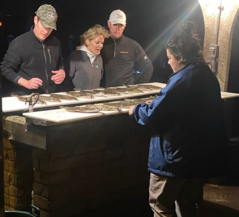
By Julie Hagen, TPWD Coastal Fisheries
In an effort to successfully manage flounder in Texas waters, the Coastal Fisheries Division is studying the nighttime flounder fishery in Matagorda, Aransas and San Antonio Bays during this harvest season.
A variety of methods will be used to capture information from flounder giggers and anglers, including nighttime creel surveys, nighttime trailer counts, and the opportunity for flounder enthusiasts to self-report their landings in Texas bay systems through the free My Texas Hunt Harvest app (MTHH).
To report your nighttime flounder catch using MTHH, go to "Fishing" and click "Flounder." You won't have to divulge your secret fishing spot, just information similar to our creel interview questions, such as the number of flounder caught, the Texas bay system you fished and the date. Easy!
Your participation is important – help improve coastal fishing by reporting your nighttime flounder fishing harvest.
(Photo credits: by TPWD staff)
|
Back to Top
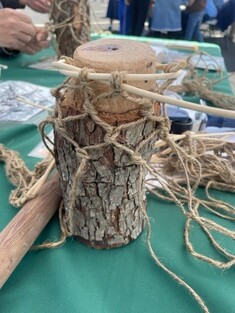
By Marni Francell, TPWD Archeology lab
When people think about prehistoric hunters, often, the first thing that comes to mind is the bow and arrow. While this likely was the preferred form of hunting for 1,100 years, there were more resources to be had than four-legged creatures. Fish were also an abundant resource for people in the past, as seen in the archeological record. Along with fish bones, scales and stone net weights, fiber nets have been recovered from dry shelters in far west Texas. Nets were used for many things, but the technology used to make them was the same whether for a fish net or a bag to carry things. Using modern materials, this activity will teach eager learners how to make a miniature pack frame and net, like the one found at Conejo Shelter in the Lower Pecos area of Texas.
Supplies needed for this activity include:
- CANING: #5 1 lb roll, cut into 27 inch pieces, soaked for 5 to 15 minutes, and wound into net rings (makes around 140). Large rings are ca. 3 inches in diameter; small rings are ca. 2.6 inches in diameter.
- JUTE (or Hemp): 400-foot rolls 3-ply “20”, cut into 4-foot pieces and tied into bundles of 6 strands, yielding 16 to 17 bundles per roll.
-
PREP NET RINGS BY TYING JUTE ONTO THEM – 6 STRANDS FOR LARGE, 5 STRANDS FOR SMALL
- 4 net supports – 2 small and 2 large-diameter made from logs
- small sample nets – several
- Laminated Images:
- net and netting (2)
- net bag carrier (1)
- fish net diagram (2)
- additional copies of fish net diagram to take home (30+)
- signs with questions:
- what are nets used for besides fishing?
- if a net has smaller holes, will you need more or less cord to make it?
- did children or grownups make nets in prehistoric times?
- FIBROUS PLANTS OF FAR WEST TEXAS
- REAL AGAVE, SOTOL, YUCCA LEAVES
- thick flake (conceptual cord cutter)
- scissors (actual cord cutters)
- large and small rocks to ‘test’ nets
|
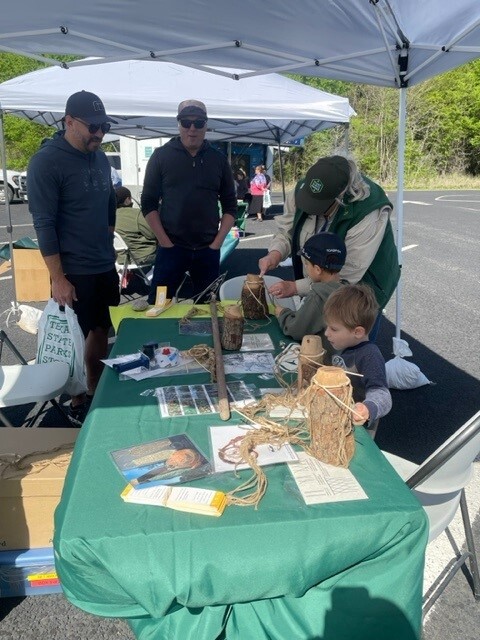 |
(Photo credits: by TPWD staff)
Back to Top
|
By Shane Wilson, Founder of Fishing's Future, TPWD Volunteer Angler Edu Area Chief
Super excited to share a novel idea given to me by one of Fishing’s Future Master Anglers. This wonderful hook tying tool is extremely easy to make, significantly helps everyone when tying knots and is a blast when collecting the corks necessary to make them.
|
|
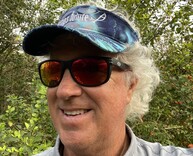 |

I suggest collecting as many corks as possible with friends. I purchase the screw eyes from a hardware store and I prefer the 1-3/8” size. Typically they come in a 40 pack for about $6.00.
|
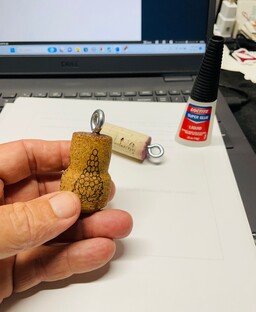
Then I get a cork and I gingerly screw the hook eye into the center of the cork that was inside the bottle. That is the tightest part of the cork and will hold the screw eye better than the damaged end. I allow the screw eye to be in the cork for a few minutes to expand the hole.
|
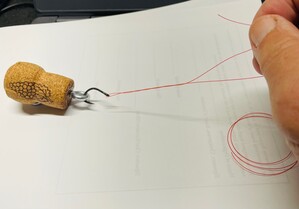
I unscrew it, put in a drop or two of super glue then rescrew in the hook eye. Now, after it dries you are ready to practice your knots.
|
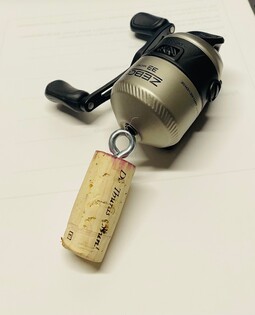
I also use this as a practice casting plug and as a line stop to keep my line from going back inside the reel. These are easily given to your participants so they can practice tying at home. Also, it gives you a reason to collect more corks.
(Photo credits: by Shane Wilson)
|
Back to Top
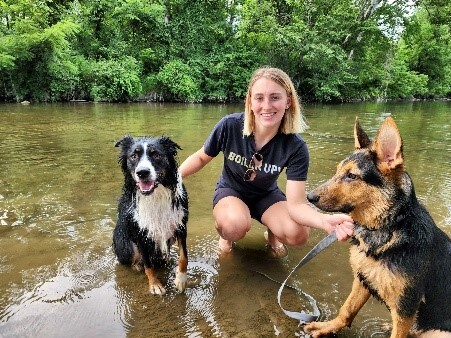
Taylor Hayes - Houston
Hello! I am one of the Aquatic Education interns this year. I am originally from Indiana but moved to Texas in January 2021. I completed my Bachelor’s of Science at Purdue University in 2020 majoring in Aquatic Sciences; freshwater and marine biology. Currently, I am getting my Master’s in Marine Biology at Texas A&M University in Galveston. I have a strong passion for the environment and for outreach education which is what has led me to this internship.
I live in Houston with my fiancé Trent and our 2 dogs, an Australian Shepherd named Luna and a German Shepherd named Milo. I enjoy spending time playing with my dogs, traveling, and doing anything outdoors. I am looking forward to collaborating with the agency and engaging with a diverse network of individuals. I am looking forward to the opportunity to use my knowledge and express my passion to others through this internship!
|

Madison Darwish- Austin
Howdy! I’m Madison Darwish and I recently graduated from Texas State University with a Bachelor of Science in Wildlife Biology. When I’m outside, my eyes are usually aimed at the sky, as I’m always listening and looking out for birds. I love field work of all kinds, whether it be with birds, bats, bugs or fish-I love getting my hiking boots dirty and breaking a sweat in the outdoors!
I enjoy volunteering at my local Raptor Rehabilitation facility, exploring the San Marcos River, and implementing my passion for the environment in any way I can in my daily life.
I have a strong passion for wildlife education and love teaching people of all ages and abilities about the water, wildlife, and the environment. I am overjoyed to have an Internship with TPWD this summer and look forward to learning new things and nurturing my reputation within the organization!
|

Julianna Semprun - North Texas
Hi! My name is Julianna Semprun and I am from Plano, Tx. I absolutely love the outdoors as well as running, baking, and working on my art projects.
I just finished my third year at Texas State University studying Aquatic Biology and minoring in Art. Combining both of my interests while choosing what to study was important to me because it means I can get the most of my education.
I choose to intern at TPWD in order to gain valuable experiences and to learn more about my future career field. I am extremely excited to get to work with my community and alongside an amazing agency!
|
Back to Top
PROGRAM UPDATES
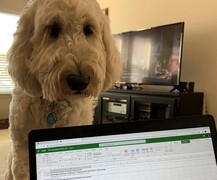
By Karen Marks, Aquatic Education Manager
We are closing out our fiscal year and grant cycle this summer on August 31st…so you know what that means…be sure to get all your reports into us so that we can include the great work you are doing on the year end reports. Even my dog Alli is helping!
Speaking of reports – we have updated the forms and included QR codes that link directly to the volunteer portal so you can easily upload your reports and rosters. All the forms are available on the Instructor’s Resources website.
HOW SMART IS YOUR SMART PHONE?
My cell phone thinks it is smarter than me! Sometimes it’s a good thing, especially with all the robo-calls. But sometimes I don’t get a call I am expecting… so I always suggest that person, text me.
Our volunteer management system has a text message option that we would like to start utilizing. But it will only work if you give us permission to text you. If you have not already opted in, please take a minute to update your volunteer profile to allow text messages. We promise not to spam you. Many people don’t read their email especially the night before a fishing event – so we would like to start utilizing the text message function to send you a shift reminder before an event, or let you know if there is a cancellation (due to weather, etc.) Of course, depending on your phone plan, message and data rates may apply.
To update your profile to receive Text messages:
|
 |
|
- Log in to your Volunteer profile at www.tpwd.texas.gov/volunteer
- Click on the “Edit Profile” on the left side under the Go Fish Logo. (Note: if doing this on your phone, scroll down to the bottom and click on “More”.)
|
.
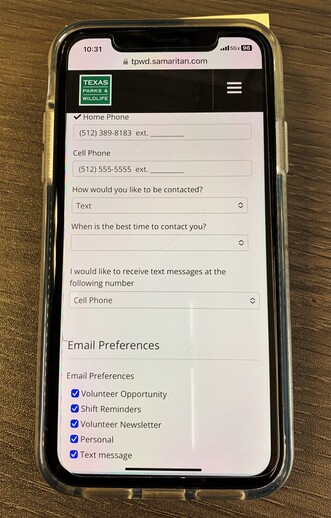 |
|
- Scroll down past all the waivers to the “Contact Information” section.
Make sure your cell phone is listed in the cell phone box, then check the “I would like to receive text messages at the following number” and enter “cell phone” in that section.
- Next, in the Email Preferences, choose the “Text Message” button, along with the other options “Volunteer Opportunity” and “Shift Reminders”.
- Finally, scroll down to the bottom and hit SAVE.
|
ORDERING SUPPLIES
The Angler Education Supply Catalog has been converted from an Adobe PDF file and is now available as a webpage that is nested under the password protected Instructor Resources web page. Descriptions and links are provided, along with suggested use for classes or events, youth or adults.
QUARANTINES!
Our Email System thought it was smart – and it recently started quarantining emails with attachments – YIKES!!! That is how y’all send in your supply orders! After a few panicked phone calls and emails, we discovered that our “updated” email system was quarantining emails without our knowledge. We have worked with our IT Department and are now receiving a daily email quarantine report. When processing supply orders, our process includes a confirmation email to you, letting you know we received the supply order – so if you don’t get a confirmation email within 3-4 days after submitting the order – call us! Apologies to those who recently submitted supply orders and didn’t get them in time for your event.
INSTRUCTOR GUIDE HIGHLIGHTS
In the new Instructor Guide on page 88, here are the answers to the questions listed in the sidebar:
If I signed-in on the roster at the event, should I also report online?
YES! We know our lead instructors do their very best, but sometimes things happen…either the new puppy chewed up the roster, or the roster blew off the dashboard and out the window on the drive home, and then sadly your time is lost.
If I am reporting my hours to the Master Naturalist (TMN) program, do I report them to the Angler Edu program too?
NO. Both the Angler Education and TMN programs collect and report volunteer hours for their respective federal aid grants and state reports. Each program also recognizes volunteers with incentive rewards. When reporting your service, you will need to decide which program you want to report to – but you may not report hours for the same event to both programs.
However, as a TMN volunteer, if you are ordering free Angler Education supplies, we ask that you please report your hours to the Angler Education program. We use the grant’s funds to support the program and purchase free supplies and equipment for events and classes.
What do I enter on the report if I don’t know the ethnicities of the participants?
You can either estimate the ethnicities OR enter the total participants in the “Unknown” section. Remember that the sum of the ethnicities should equal the sum of the gender (male/female) sections.
If I am a TPWD employee, do I report my hours?
We ask that employees enter a logbook with the class/event logistics and participants but leave the hours section blank (Check the I am a paid TPWD employee or contractor). At the end of the year, we will sing your praises to your bosses too!
(Photo credits: by TPWD staff)
Back to Top
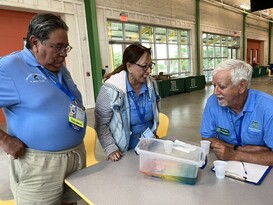
We hosted the 21st annual Area Chief Volunteer Training meeting in late April at Camp Aranzazu in Rockport, TX. Seven new Area Chiefs attended along with 17 current Area Chiefs. In addition to the Angler Education team, we had staff from other TPWD Divisions join us too.
We opened with a fun icebreaker and a look at our program statistics over the years. Leslie Hartman with Coastal Fisheries presented about how to improve our communication strategies. Melissa Felty-Alderson (Conservation Education) and Robert Ramirez taught a fun Texas Waters activity on ocean currents. Keira Quam and Greg Akins discussed the ins/outs of teaching online. Heather England and Adam Comer reminded us of all the cool teaching resources available on the TPWD website. Kim Sorensen (Boater Education Manager) reviewed Boater Safety topics. Game Warden Justin Solis and his partner Ashton Gulczewski joined us for a Q&A about fishing regulations.
We had some robust discussions during the round table sessions – key points included,
- You don’t need expensive equipment to enjoy fishing!
- Places to recruit new volunteers ( school PTA, Churches, Civic Clubs, Fishing Clubs, and the VFW)
- Sit in on someone else’s workshop or class to pickup teaching tips and tricks.
- Switch up your agenda and teach safety first.
|
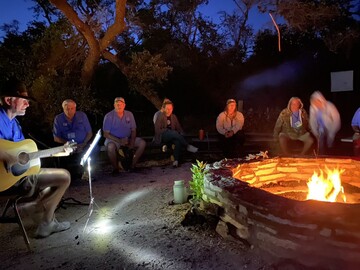
During our free time, we did some fishing on the bay – several hard-heads were caught and we heard tall fish tales of a big Red Fish that got away. Keira led a fly tying session and Area Chief Walter McLendon taught fly casting. Area Chief Ted Moore entertained us around the campfire while we ate yummy s’mores.
Each year we rotate the training meeting around the three major staff regions – next year we plan to host the meeting somewhere in North Texas. If you’re interested in taking the next step in your volunteer journey and becoming a volunteer trainer – contact your regional staff person. To be eligible, instructors must have taught a minimum of 25 hours, demonstrate leadership by serving as “Lead” at a class or event; and report online and teach others to do the same.
|
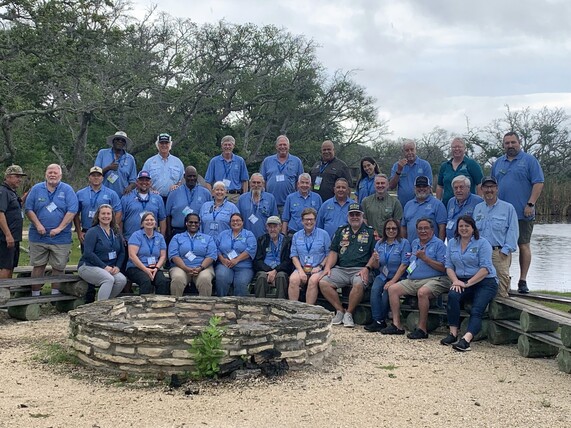 (Photo credits: by TPWD staff)
Back to Top
Volunteer Area Chief trainers and staff have been teaching both online and in-person workshops to certify instructors. Go to the website to check out the list and welcome our New Instructors! Since January of this year, we have trained 332 new instructors! Way to go Angler Edu Instructors!
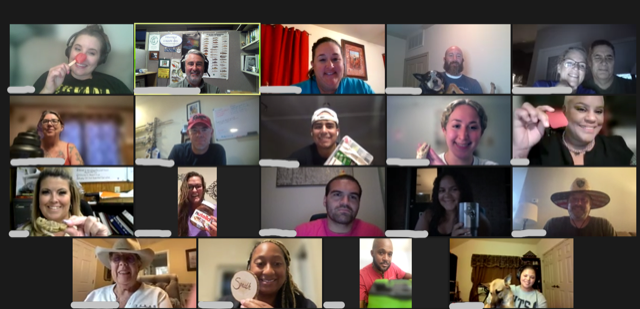
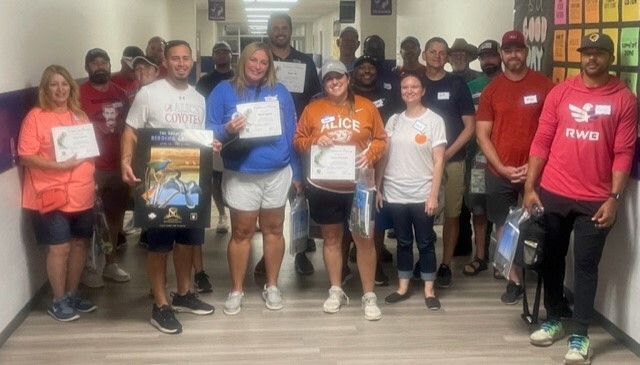 (Photo credits: by TPWD staff)
Back to Top
Texas State Parks are hosting events every month of the year across the state like the one below: "Festival of the Fish" at Cooper Lake State Park. Entry to the park is free during these events! Check out the calendar for an event in your area of the state and sign up to join staff and volunteers as we celebrate 100 years of Texas State Parks!
(Photo credits: by TPWD staff)
Back to Top
Check out past issues of Reel Lines newsletters to find additional tips and ideas for teaching Angler Education!
Angler Education Program | Texas Angler Educators Facebook
Learn to Fish Videos | Texas Aquatic Science | TPWD Fishing Information
Volunteer Portal | In Memoriam | Staff Contacts
Angler Education Instructor Workshops, Fishing Events, Fly Fishing Events, Texas Freshwater Fisheries Center, Sea Center Texas
|